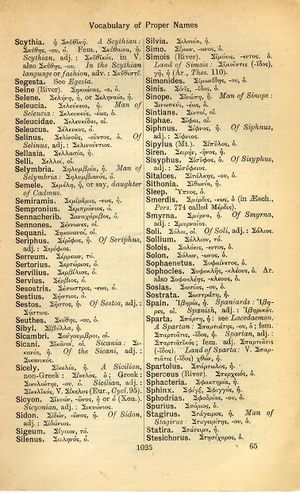Sphinx
πάντων χρηµάτων µέτρον ἐστίν ἄνθρωπος, τῶν µέν ὄντων ὡς ἐστιν, τῶν δέ οὐκ ὄντων ὡς οὐκ ἔστιν → man is the measure of all things, of things which are, that they are, and of things which are not, that they are not (Protagoras fr.1)
English > Greek (Woodhouse)
Σφίγξ, Σφιγγός, ἡ.
Latin > English (Lewis & Short)
Sphinx: ngis (Gr.
I gen. Sphingos, Stat. Th. 1, 66), f., = Σφίγξ.
I A fabulous monster near Thebes that used to propose riddles to travellers, and tear in pieces those who could not solve them; usually represented with the head of a woman and the body of a lion, afterwards also with the wings of a bird; or, also, with the head of a man and the body of a lion, Plin. 36, 12, 17, § 77 sqq.; Aus. Idyll. 11, 40; Sen. Phoen. 119; id. Oedip. 92; Stat. Th. 1, 66; Plaut. Poen. 1, 3, 35; Hyg. Fab. 67 al.—Augustus had the figure of a sphinx upon his seal, as a symbol of silence, Suet. Aug. 50; Plin. 37, 1, 4, § 10.—Plur.: pedes formati in speciem sphingum, Fest. s. v. picati, p. 206.— In a lusus verbb., Quint. 6, 3, 98.—
II A species of ape, perh. the chimpanzee, Plin. 8, 21, 30, § 72; Mel. 3, 9; Sol. 27 fin.>
German > Latin
Sphinx, Sphinx.
Latin > German (Georges)
Sphīnx, Sphīngis, f. (Σφίγξ), I) die Sphinx, ein weibliches Ungeheuer bei Theben, das jedem Vorbeigehenden ein Rätsel aufgab und den zerriß, der es nicht erriet; bei den Ägyptern (von denen die Gestalt der Sphinx entlehnt ist) als ein geflügelter liegender Löwe mit menschlichen Oberteilen, bei den Griechen (u. Römern) gew. als ein ungeflügelter Löwenrumpf mit Kopf u. Brust einer Jungfrau abgebildet, Plaut. Poen. 444. Auson. edyll. 11, 41. p. 130 Schenkl: griech. Genet. Sphingos, Stat. Theb. 1, 66: griech. Akk. Sphinga, Ov. trist. 4, 7, 17; Ib. 380. Sen. Oedip. 92: Genet. Plur. Sphingum, Fest. 206, 3. Vgl. Sphinga. – eine Sph. als Siegelbild, Suet. Aug. 50. – im Wortspiele, Quint. 6, 3, 98. – II) sphīnx, eine Art Affen, vielleicht der Schimpanse (Simia Troglodytes, Gmel.), Mela u.a. / Nbf. Sphinga, s. bes.

